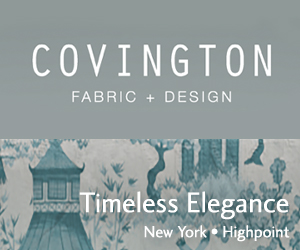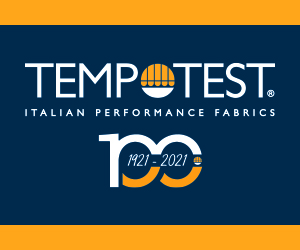At Cologne, Furniture Design Demonstrates a New Modernism
April 18, 2002
Cologne (Germany) - For connoisseurs of contemporary design, the International Furniture Fair is the place to be in January. With hardly a floral pattern in sight, the event showed that chenille yarns are still popular as furnishing fabrics, while interesting materials such as new heard-wearing fabrics are beginning to make their presence felt. Velour fabrics and plain wovens continue their domination of upholstery fabrics as the use of leather and suede-like Alcantara also strengthens.
Trade analysts say furniture design is fast moving toward two camps: modern classics in timelessly stylish designs and minimalist contemporary style. Today''s home demands upholstered furniture with a host of functions and features such as headrests, armrests, footrests, electronic reclining motions and sofas that convert to beds.
This trend toward contemporary functionality includes the increasing use of the home as an extension of the office: the inclusion of fold-out tables to accommodate computer laptops is just one example of this movement.
In the contemporary furniture market, Nikolas Norling of Uptown Copenhagen, Denmark, commented on the return to box-type models with straight lines, square arms and box legs.
"This has slightly changed the type of upholstery fabric in demand. For example, fewer colors are being used than before. There are also more plain fabrics now as opposed to prints and patterns," Norling said, adding that Uptown Copenhagen sources fabrics from "a major US firm" as well as from Italy and Turkey, among others.
Furniture from Steinhoff International of Westerstede, Germany, is made using a wide range of upholstery fabric. As the majority of models are produced in Germany and Poland, most fabric is also purchased in these countries, with principal suppliers including Freudenberg and Glatzeder.
Steinhoff noted that modular systems and automated manufacturing are increasingly becoming important production elements. This means that prefabricated elements are supplied to the factories, where they are then assembled to make up the finished product. The company has plans to standardize the incoming materials, including fabrics, in the interests of improving logistics.
Italian upholstered furniture maker Gruppo Industriale Busnelli of Misinto said it uses only high quality fabrics, preferably of natural fibers, sourced exclusively from Italian suppliers. The company noted the trend to fabrics with a "dense" hand and also the offer of Panama-type satin fabrics in noble fibers such as linen and wool. "Fashion in the furniture industry mainly influences colors rather than the type of fabric used," Busnelli pointed out.
Gepade of Delbruck, a family-owned producer of classical and contemporary upholstered furniture, is one of the last remaining manufacturers in Germany that processes raw beech-wood for the frames of its sofas.
Due to the long warranties of its frames (up to ten years) and upholstery and fillings (five years), the company concentrates on branded, long-warranty fabrics. The main suppliers are Rohleder of Germany and Alcantara of Italy, said export manager Sven Schreiber.
Around 50% of the fabrics used on export models come from Gepade''s main collection, with the other half from regional suppliers, who are usually wholesalers, said Schreiber. "These wholesalers have to pass our supplier approval procedure and must name the producers of the fabrics."
Gepade is currently planning launches into the U.K. and U.S. markets with design-oriented modern models and is sourcing the required flame-retardant fabrics - as it does in all countries where it is active - partly from its regular suppliers in Germany and Italy, but also from the markets themselves.
"Trends in upholstery design and production in our high-price segment are quite clear: the customer expects added value for his/her money," said Schreiber. "This means not only good design, but also a high degree of comfort, which is not always the case with designer sofas, and a ''feelable'' quality. "Added functions, such as worktables, telephone and modem connections built into the backrest or armrest, are also becoming increasingly important. Elements that have become standard in many of our models include glass shelves and a choice of light systems, both of which can be attached to the sofa itself."
Johannes Weibel of Intertime, Endingen, Switzerland, said the company''s upholstery fabrics were generally constructed of microfiber, wool and Trevira, and sourced from such suppliers as Kvadrat, Gabriel, Shacco, Hesslein and Alcantara. He said fabrics continued to be plain and structured with a more natural touch.
Thomas Jungjohann, chief executive officer of upholstered furniture manufacturer Erpo Möbelwerk of Ertingen, Germany, commented on the fashion for plain colors, in light or natural shades, particularly in all kinds of blue. Flat woven, velvet and Alcantara fabrics are sourced from Germany, Italy, Denmark, Belgium and the Netherlands.
At Cologne, Erpo featured its new information technology (IT) network, which includes an e-business platform. Some 15 million customers in Germany said they would like to inform themselves actively via the Internet before they buy furniture, according to a study of the BBE-Institute, Cologne.
Under the Erpo and Dreipunkt brand names, the company''s exports account for almost 30% of sales, principally to other European countries. However, the International Furniture Fair provided new contacts in the USA, Thailand and the CIS, which will build on existing trade relations with Japan and Korea.
Jungjohann said the outlook for the upholstered furniture industry in Germany is critical. "The number of players will be reduced in the future," he commented. "The strong will become stronger and the weak will disappear. Size alone will not be the criteria for strength or weakness.
"Regardless of what will happen, we are well prepared. Our investment in IT gives us a splendid start. But despite this future orientation, Erpo continues to be governed by concentrating on the essential and focusing on core competence - knowing what customers really want, how to accommodate comfortable seating and how to manufacture high-class upholstered furniture," said Jungjohann, who is a director of both the German furniture and upholstered furniture industry associations.
Stefan Gabel, creative director - textiles at WK-Wohnen of Leinfelden-Echterdingen, Germany, argued that colors in upholstery fabrics are becoming more intense and expressive. He said: "Very modern forms in furniture design are allowing expressive weaving structures in textiles that are reminiscent of handmade weaves. This provides an exciting, new clear style." WK-Wohnen uses many kinds of woven textiles in a range of different materials from noble fibers such as alpaca and wool to the more practical Trevira CS. Fabrics are sourced as chenille, boucè velour and damask mainly from Germany, Italy and Switzerland.
In terms of fabric trends, the company noted more plains with interesting structures and a pleasing touch, and the use of top quality materials. Gabel added that patterned fabrics are now being used with plains, but only for one part of the furniture or for cushions.
According to Duncan Bassett of Collins & Hayes, St Leonards on Sea, East Sussex, UK, "the fabric trend is toward texture and neutral colors, such as beige and off-white, as well as to soft leathers in tan, chocolate brown and creams. We are also seeing the beginnings of a return to natural fibers, especially linen and wool, as well as patterns and florals," he said. "We have also noticed a trend toward mix-and-match furniture, with consumers buying separate pieces to fit in with existing items, rather than purchasing complete three-piece suites. Most of our sales are in loose covers, which offer a casual elegance, especially in light colors."
Collins & Hayes, which sources fabric worldwide, mainly from Germany, France and the UK, together with linens from Belgium and textured fabrics from Italy, is geared principally to supplying the UK market. However, Bassett explained that there is some demand from the rest of Europe. "We have had a good reception from the public in Cologne," he said.
Turkish company Yatpa of Izmir has developed a range using high quality fabrics, such as a luxurious cotton/silk blend, as well as novel microfiber constructions, all sourced from Turkey. With products in modular and upholstered furniture and mattresses, the firm exports 80% of production from three factories, said spokesperson Ertan Basli. F&FI
Trade analysts say furniture design is fast moving toward two camps: modern classics in timelessly stylish designs and minimalist contemporary style. Today''s home demands upholstered furniture with a host of functions and features such as headrests, armrests, footrests, electronic reclining motions and sofas that convert to beds.
This trend toward contemporary functionality includes the increasing use of the home as an extension of the office: the inclusion of fold-out tables to accommodate computer laptops is just one example of this movement.
In the contemporary furniture market, Nikolas Norling of Uptown Copenhagen, Denmark, commented on the return to box-type models with straight lines, square arms and box legs.
"This has slightly changed the type of upholstery fabric in demand. For example, fewer colors are being used than before. There are also more plain fabrics now as opposed to prints and patterns," Norling said, adding that Uptown Copenhagen sources fabrics from "a major US firm" as well as from Italy and Turkey, among others.
Furniture from Steinhoff International of Westerstede, Germany, is made using a wide range of upholstery fabric. As the majority of models are produced in Germany and Poland, most fabric is also purchased in these countries, with principal suppliers including Freudenberg and Glatzeder.
Steinhoff noted that modular systems and automated manufacturing are increasingly becoming important production elements. This means that prefabricated elements are supplied to the factories, where they are then assembled to make up the finished product. The company has plans to standardize the incoming materials, including fabrics, in the interests of improving logistics.
Italian upholstered furniture maker Gruppo Industriale Busnelli of Misinto said it uses only high quality fabrics, preferably of natural fibers, sourced exclusively from Italian suppliers. The company noted the trend to fabrics with a "dense" hand and also the offer of Panama-type satin fabrics in noble fibers such as linen and wool. "Fashion in the furniture industry mainly influences colors rather than the type of fabric used," Busnelli pointed out.
Gepade of Delbruck, a family-owned producer of classical and contemporary upholstered furniture, is one of the last remaining manufacturers in Germany that processes raw beech-wood for the frames of its sofas.
Due to the long warranties of its frames (up to ten years) and upholstery and fillings (five years), the company concentrates on branded, long-warranty fabrics. The main suppliers are Rohleder of Germany and Alcantara of Italy, said export manager Sven Schreiber.
Around 50% of the fabrics used on export models come from Gepade''s main collection, with the other half from regional suppliers, who are usually wholesalers, said Schreiber. "These wholesalers have to pass our supplier approval procedure and must name the producers of the fabrics."
Gepade is currently planning launches into the U.K. and U.S. markets with design-oriented modern models and is sourcing the required flame-retardant fabrics - as it does in all countries where it is active - partly from its regular suppliers in Germany and Italy, but also from the markets themselves.
"Trends in upholstery design and production in our high-price segment are quite clear: the customer expects added value for his/her money," said Schreiber. "This means not only good design, but also a high degree of comfort, which is not always the case with designer sofas, and a ''feelable'' quality. "Added functions, such as worktables, telephone and modem connections built into the backrest or armrest, are also becoming increasingly important. Elements that have become standard in many of our models include glass shelves and a choice of light systems, both of which can be attached to the sofa itself."
Johannes Weibel of Intertime, Endingen, Switzerland, said the company''s upholstery fabrics were generally constructed of microfiber, wool and Trevira, and sourced from such suppliers as Kvadrat, Gabriel, Shacco, Hesslein and Alcantara. He said fabrics continued to be plain and structured with a more natural touch.
Thomas Jungjohann, chief executive officer of upholstered furniture manufacturer Erpo Möbelwerk of Ertingen, Germany, commented on the fashion for plain colors, in light or natural shades, particularly in all kinds of blue. Flat woven, velvet and Alcantara fabrics are sourced from Germany, Italy, Denmark, Belgium and the Netherlands.
At Cologne, Erpo featured its new information technology (IT) network, which includes an e-business platform. Some 15 million customers in Germany said they would like to inform themselves actively via the Internet before they buy furniture, according to a study of the BBE-Institute, Cologne.
Under the Erpo and Dreipunkt brand names, the company''s exports account for almost 30% of sales, principally to other European countries. However, the International Furniture Fair provided new contacts in the USA, Thailand and the CIS, which will build on existing trade relations with Japan and Korea.
Jungjohann said the outlook for the upholstered furniture industry in Germany is critical. "The number of players will be reduced in the future," he commented. "The strong will become stronger and the weak will disappear. Size alone will not be the criteria for strength or weakness.
"Regardless of what will happen, we are well prepared. Our investment in IT gives us a splendid start. But despite this future orientation, Erpo continues to be governed by concentrating on the essential and focusing on core competence - knowing what customers really want, how to accommodate comfortable seating and how to manufacture high-class upholstered furniture," said Jungjohann, who is a director of both the German furniture and upholstered furniture industry associations.
Stefan Gabel, creative director - textiles at WK-Wohnen of Leinfelden-Echterdingen, Germany, argued that colors in upholstery fabrics are becoming more intense and expressive. He said: "Very modern forms in furniture design are allowing expressive weaving structures in textiles that are reminiscent of handmade weaves. This provides an exciting, new clear style." WK-Wohnen uses many kinds of woven textiles in a range of different materials from noble fibers such as alpaca and wool to the more practical Trevira CS. Fabrics are sourced as chenille, boucè velour and damask mainly from Germany, Italy and Switzerland.
In terms of fabric trends, the company noted more plains with interesting structures and a pleasing touch, and the use of top quality materials. Gabel added that patterned fabrics are now being used with plains, but only for one part of the furniture or for cushions.
According to Duncan Bassett of Collins & Hayes, St Leonards on Sea, East Sussex, UK, "the fabric trend is toward texture and neutral colors, such as beige and off-white, as well as to soft leathers in tan, chocolate brown and creams. We are also seeing the beginnings of a return to natural fibers, especially linen and wool, as well as patterns and florals," he said. "We have also noticed a trend toward mix-and-match furniture, with consumers buying separate pieces to fit in with existing items, rather than purchasing complete three-piece suites. Most of our sales are in loose covers, which offer a casual elegance, especially in light colors."
Collins & Hayes, which sources fabric worldwide, mainly from Germany, France and the UK, together with linens from Belgium and textured fabrics from Italy, is geared principally to supplying the UK market. However, Bassett explained that there is some demand from the rest of Europe. "We have had a good reception from the public in Cologne," he said.
Turkish company Yatpa of Izmir has developed a range using high quality fabrics, such as a luxurious cotton/silk blend, as well as novel microfiber constructions, all sourced from Turkey. With products in modular and upholstered furniture and mattresses, the firm exports 80% of production from three factories, said spokesperson Ertan Basli. F&FI
















